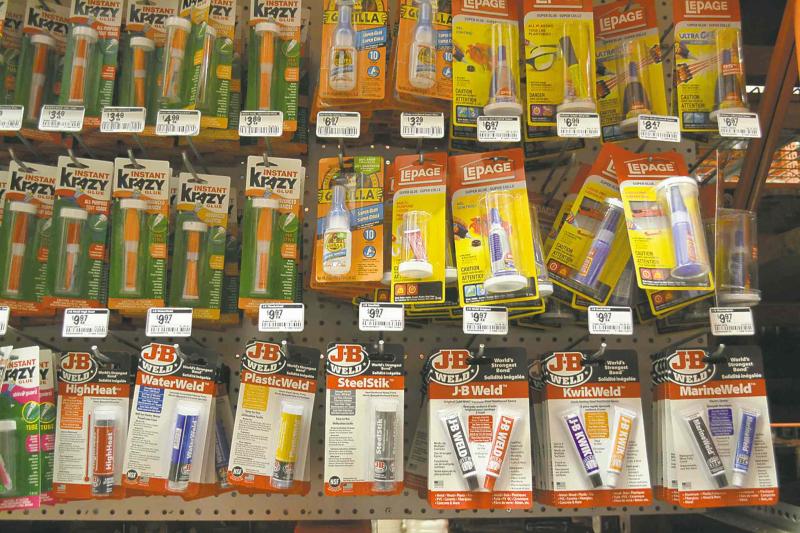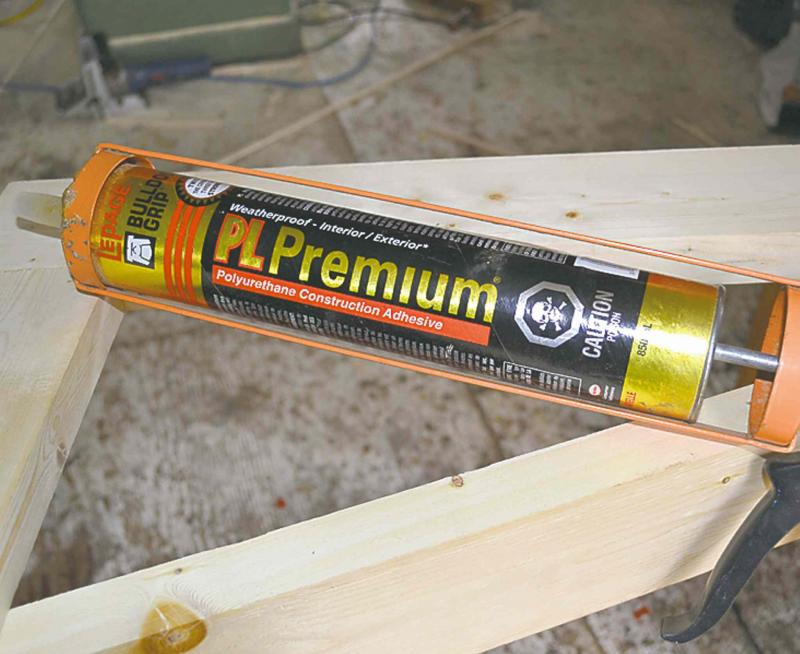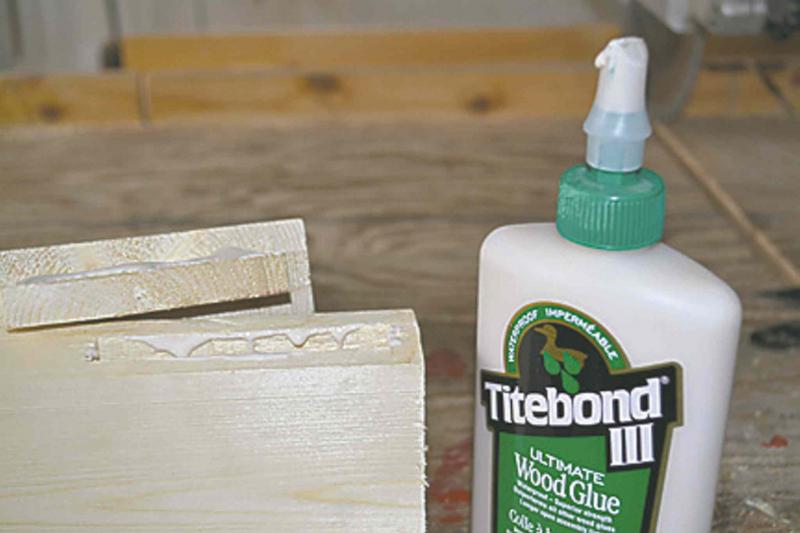

There is such a glut of adhesives on the market these days that a person almost needs a pharmacopeia of the glues to understand when, where and how to use them effectively.
I thought it might be useful to examine some of the most products available to renovators, DIYers and the public.
In the mid-70s, I worked as a furniture maker with three other lads. Back then, the adhesive of choice for woodworking and many other uses was white glue as it was readily available, inexpensive and reliable.
We inadvertently ran a test strength on white glue one day when we were delivering a walnut cabinet to a customer. We'd carefully strapped the cabinet to the roof rack of my '68 VW Beetle and were heading north over the Arlington Street Bridge when a nasty gust of wind tore the roof rack and cabinet off the top of the car. We watched them sail over the safety rail, spiralling into the CPR rail yard below. Looking down from the pedestrian walk, we spotted the cabinet on top of a boxcar that was slowly being shunted through the yard. Though the wood was badly shattered in many places, most of the joints remained intact. If we'd had a camera, the picture would have made an astonishing testimonial for the glue manufacturer, in this case Weldbond.
Not long after that, the adhesive industry began to promote yellow glues "specifically formulated for the woodworker." As it turned out, the main difference between white and yellow glue was the colour (produced by adding a yellow dye). True, white glue tends to melt more quickly when it is machine-sanded, causing belts to clog; however, its yellow counterpart has a strong initial tack that can be annoying if a joint needs to be adjusted before it is clamped. Moreover, some research suggests after-tack movement can weaken high-tack glues' final bonding strength. Be this as it may, white and yellow glues are both water-soluble polyvinyl acetates that dry by evaporation of the solvent (water) and gain strength by forming long carbon molecule chains, referred to as polymerization. To form a proper bond, they must be used between 10 C and 40 C; below 10 C the glue will not dry and above 40 C the open (working) time is reduced drastically.
The price of white or yellow glue does not reflect its performance. Buying larger quantities will save money, but purchasing a name-brand product is no guarantee it will outperform generic or store brands. For example, Home Hardware sells its own Home-Bond yellow glue for about half the price of Titebond III, a highly touted yellow adhesive marketed as the "ultimate wood glue." A further claim on the front label says the product is waterproof, but if you read the small print on the back it reads "not for continuous submersion or below the water line." In this case, water-resistant would be more accurate to describe the glue. In my woodworking experience, Titebond III does not out perform less costly generic products.
As general purpose water-based adhesives, white or yellow glues are ideal for DIYers who need an inexpensive product that will bond glass, porcelain, wood, paper and many other materials. Dry glue can be broken down by applying acetone to the joint or immersing it in water for a few hours. (PVA glues that freeze should be thrown out.)
White glue (yellow can be used, too) is also mixed with mortar and stucco cement to increase the tackiness. If you are pouring a finishing coat of concrete on top of an existing concrete substrate, a three-to-one mix of water to white or yellow glue brushed or rolled over the old surface will help the skim coat adhere and prevent it from cracking.
If you require an adhesive that is truly waterproof, there are two glues I can recommend. One is a two-part urea formaldehyde called Resorcinol that is used in boat and outdoor wood construction. When cured, it will withstand temperature variations from sub-zero to tropical heat and remain waterproof when immersed in salt or fresh water. This excellent glue is becoming more difficult to source because of the proliferation of two-part epoxy formulations that have superior gap-filling qualities and dry clear. (Resorcinol leaves a dark glue line that is unsightly on light woods.) The downside to two-part epoxies is that they must be mixed with extreme care as too much catalyst will cause the glue to set in minutes; too little catalyst will prevent the glue from setting at all. (I know this from a bitter and costly experience I encountered while applying fibre glass cloth with epoxy to the hull of a cedar strip canoe I built with a friend, Bruce Morrish.) Another problem is to know how much resin/catalyst to mix for the job at hand. This is something that can only be learned by experience; I tend to over mix, which is wasteful, but it's better than under mixing when you're in the middle of a crucial glue-up.
Cargo East Marine in St. Boniface is an ideal place to buy epoxy. This boating speciality store sells West System products that have a good reputation. A gallon of resin is $120, the hardener or catalyst is $50 (special clear is $95) and a set of three pumps to ensure the required five-parts resin to one-part hardener is consistent sells for $17.
In my experience, fast setting five-minute epoxies are not very good for mending small wood, ceramic or glass objects because the pieces need to be clamped (held together with your fingers) until the glue forms a solid bond. In the shop, I use five-minute epoxy mixed with sawdust as a small gap filler because, unlike Plastic Wood, it does not shrink when it dries, requiring a second filler coat. Moreover, the gap is almost invisible because the epoxy is combined with sawdust from the wood that is being filled. Unless it is painted or heavily stained, Plastic Wood is visible through a dozen coats of varnish.
I'm not a fan of one-part polyurethane products such as Gorilla glue because they fizz up or expand quickly when applied to a joint, creating a big mess that must be cleaned up with acetone before the glue has set. Moreover, removing dry glue from your fingers requires soaking in warm water and soap while applying liberal amounts of nail polish remover (acetone or lacquer thinner). Polyurethanes may be super strong adhesives, but for the majority of jobs, water-soluble PVAs will work just as well.
Another commonly used adhesive is cyanoacrylate (CA), known by trade names such as Super Glue or Krazy Glue. I have found no use for the CAs with the consistency of water except for welding my fingers together. (I believe a woman jilted by her husband found a creative use for the adhesive, but, as this is a family column, I can't go into details here.) However, a friend of mine who recently became a grandfather and, at the same time, inherited the title of chief toy repairer, said that a gel form of CA is excellent for bonding wood, glass, ceramic and some polymer products.
"A bead of gel remains on the surface of a break instead of running down the sides of the piece being repaired," said Bob Johnston. "Because the bead remains in place, clamping pressure can be easily applied without the adhesive leaking out of the joint." As with most glue, Johnston recommends not stressing the joint for 24 hours, leaving sufficient time for the adhesive to completely set.
Products made of polystyrene or polyurethane including white Styrofoam (bead board) require a special adhesive to bond them together or to glue them to another type of substrate; most glues contain chemicals that will burn through the polymer or will not stick to it. LePage manufactures an adhesive called PL300 that is specifically formulated to bond polystyrene and polyurethane panels. It is sold in lumber stores in 266 ml tubes that fit into a standard caulking gun.
Vapour barrier (six mm poly) seams require a special adhesive marketed under various trade names, the most common being Acousti-Seal. Like many construction glues, it can be purchased in tubes that fit into regular or large caulking guns. Red Tuck tape can be used in place of Acousti-Seal; however, the building code states a bead of adhesive must seal a vapour barrier to the bottom plates of exterior walls.
Other construction resins sold in tubes include block adhesives for outdoor projects that require a weather proof seal for brick, stone, timbers and concrete. LePage's Landscape made expressly for this purpose sells for about $4.70 for a regular size tube.
General construction glues such as PL Premium sell for $11.50 large and $5.70 small tube. If you read the technical data on this product, you may wonder why LePage bothers to produce a line of specialty adhesives. The answer is that PL Premium is a mess waiting to happen. It is a polyurethane adhesive similar to Gorilla glue that expands when released from the container, sticking persistently to everything and anything it encounters. If you use this adhesive, wear old clothing, latex gloves and eye protection. That being said, PL Premium will bond wood, hardwood flooring, concrete, stone, marble, slate, masonry, brick, foam insulation, carpets, metal, cement-based products, ceramic, Fibreglass, drywall and mirrors.
Specialty caulking glues retailed by LaPage include PL 610 mirror adhesive, $6.50 for a small tube; PL 620 granite and marble adhesive, $8.50 small tube; and No More Nails, sold as caulks or in other applicators.
The mirror adhesive has a 10-minute open time, unlike the immediate grab of most polyurethanes, and appears to be an acetate-based glue containing methyl acetate, limestone, kaolin, titanium dioxide and quartz. I haven't used this product, but a salesperson at Home Hardware in Selkirk said LePage's PL 9000 will do the same job at a lower price and can be used for bonding other materials than mirror.
PL 620 Granite and Marble adhesive and No More Nails are polyurethane formulations that are more pricey than the versatile PL Premium or PL 9000. So once again, why waste money on specialty glues when general-purpose products work just as well?
As there is no end to the adhesives available, I will conclude with a brief description of my favourite edge banding and veneering glue, contact cement. This product must be applied to both the substrate and the back of the veneer and allowed to dry for 20 minutes at room temperature before bonding. Because it has a completely smooth surface and does not move with changes in temperature and humidity such as wood, MDF is a highly recommended substrate. Contact cement can be brushed or rolled onto a surface and cleaned up before it has set with contact cement solvent, a mixture of naphtha, acetone and toluene. Always wear a mask when working indoors with contact glues or work outside or buy low-odour, water-based alternatives.
To bond a sheet of veneer such as arborite to a substrate, cover the substrate with wax paper leaving about five centimetres exposed along the starting edge. Carefully place the veneer so it will align with the substrate, then use a rolling pin to bond the two surfaces. As you continue to roll, move the wax paper to uncover more of the substrate. This prevents the veneer from prematurely sticking to the substrate, resulting in bubbles or areas of poor adhesion that may lift later on. This simple trick also works on edge banding.
With the proliferation of adhesives, big-box stores that cater to DIYers have demanded glue manufacturers provide detailed information on usage on their products either on the packaging or in pamphlets. This information can be helpful when you are deciding what glue to use for what job.
I have found salespeople in Rona stores in Winnipeg and Home Hardware stores outside the city are the most knowledgeable about the products they sell.




